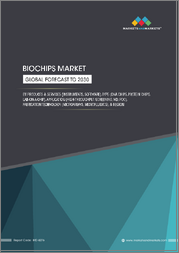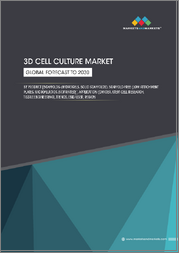
|
시장보고서
상품코드
1673818
마이크로플루이딕스 시장 규모, 점유율, 성장 분석 : 제품별, 재료별, 용도별, 최종사용자별, 지역별 - 산업 예측(2025-2032년)Microfluidics Market Size, Share, and Growth Analysis, By Product (Microfluidics-based Device, Microfluidic Components), By Material (Glass, Silicon), By Application, By End User, By Region - Industry Forecast 2025-2032 |
||||||
마이크로플루이딕스 시장 규모는 2023년 244억 8,000만 달러로 평가되었습니다. 또한, 예측 기간(2025-2032년) 동안 12.8%의 연평균 복합 성장률(CAGR)로 2024년 276억 1,000만 달러에서 2032년 723억 7,000만 달러로 성장할 것으로 예상됩니다.
마이크로플루이딕스 시장은 만성질환 및 감염성 질환의 확산, 고령 인구 증가 등을 배경으로 빠르게 성장하고 있습니다. 마이크로플루이딕스 디바이스는 액체와 기체의 고유한 물리-화학적 특성을 마이크로 스케일로 활용하고, 더 적은 양의 시료와 시약을 분석하여 용도 비용을 절감할 수 있습니다. 진단, 암 검진, 세포 조작 등 다양한 공정에서 널리 사용되고 있습니다. 특히, uFluidix의 생산능력 증설과 열가소성 마이크로유체칩 제조의 기술 혁신으로 대표되는 제조업체들은 새로운 시장 진입을 위한 노력을 강화하고 있습니다. 전반적으로 미국 마이크로플루이딕스 시장은 업계의 지속적인 발전과 시장의 관심 증가를 반영하여 향후 몇 년동안 지속적인 성장을 이룰 것으로 예상됩니다.
목차
서론
- 조사 목적
- 조사 범위
- 정의
조사 방법
- 정보 조달
- 2차 데이터 소스와 1차 데이터 소스
- 시장 규모 예측
- 시장 전제조건과 제한
주요 요약
- 시장 개요 전망
- 공급 수요 동향 분석
- 부문별 기회 분석
시장 역학과 전망
- 시장 역학
- 성장 촉진요인
- 기회
- 성장 억제요인
- 과제
- Porter의 Five Forces 분석
주요 시장 인사이트
- 기술 분석
- 가격 분석
- 밸류체인 분석
- 시장 생태계
- 사례 연구
- 특허 분석
- 고객과 구매 기준 분석
- 규제 상황
- 거시경제 지표
- PESTEL 분석
- 주요 투자 분석
- 주요 성공 요인
- 경쟁 정도
마이크로플루이딕스 시장 : 제품별&CAGR(2025-2032년)
- 시장 개요
- 마이크로플루이딕스 디바이스
- 마이크로플루이딕스 컴포넌트
- 마이크로플루이딕스 칩
- 유량 및 압력 센서
- 유량 및 압력 컨트롤러
- 마이크로펌프
- 마이크로플루이딕 밸브
- 마이크로니들
- 기타 컴포넌트
마이크로플루이딕스 시장 : 소재별&CAGR(2025-2032년)
- 시장 개요
- 유리
- 실리콘
- 폴리머
- 기타
마이크로플루이딕스 시장 : 용도별&CAGR(2025-2032년)
- 시장 개요
- 체외진단
- 임상 진단
- POC(Point of Care) 검사
- 수의 진단
- 의약품 및 생명과학 연구와 제조
- 실험실 분석
- 단백질체 분석
- 유전체 분석
- 세포 기반 분석
- 모세관 전기영동
- Microdispensing
- Microreaction
- 치료제
- 약물전달
- 웨어러블 디바이스
마이크로플루이딕스 시장 : 최종사용자별&CAGR(2025-2032년)
- 시장 개요
- 병원 및 진단센터
- 학술연구기관
- 제약 기업 및 바이오테크놀러지 기업
마이크로플루이딕스 시장 규모 : 지역별&CAGR(2025-2032년)
- 시장 개요
- 북미
- 미국
- 캐나다
- 유럽
- 독일
- 스페인
- 프랑스
- 영국
- 이탈리아
- 기타 유럽
- 아시아태평양
- 중국
- 인도
- 일본
- 한국
- 기타 아시아태평양
- 라틴아메리카
- 브라질
- 기타 라틴아메리카
- 중동 및 아프리카
- GCC 국가
- 남아프리카공화국
- 기타 중동 및 아프리카
경쟁 구도
- 주요 5개사 비교
- 주요 기업의 시장 포지셔닝(2024년)
- 주요 시장 기업이 채택한 전략
- 시장에서의 최근 활동
- 기업의 시장 점유율 분석(2024년)
- 주요 기업 개요
- 기업 상세
- 제품 포트폴리오 분석
- 기업 부문별 점유율 분석
- 매출 전년대비 비교(2022-2024년)
주요 기업 개요
- Thermo Fisher Scientific(US)
- Becton, Dickinson, and Company(US)
- Agilent Technologies(US)
- Bio-Rad Laboratories(US)
- F. Hoffmann-La Roche(Switzerland)
- Danaher Corporation(US)
- Illumina Inc.(US)
- Fluidigm Corporation(US)
- Abbott Laboratories(US)
- BioMerieux(France)
- Hologic(US)
- Quidel Corporation(US)
- SMC Corporation(Japan)
- Parker-Hannifin Corporation(US)
- IDEX Corporation(US)
- Fortive Corporation(US)
- Aignep S.p.A(Italy)
- Dolomite Microfluidics(UK)
- Elveflow(France)
- uFluidix(Canada)
- NanoString Technologies(US)
- Nortis Inc.(US)
- Innovative Biochips, LLC(US)
- Fluidic Analytics(UK)
결론과 제안
LSH 25.04.16Microfluidics Market size was valued at USD 24.48 billion in 2023 and is poised to grow from USD 27.61 billion in 2024 to USD 72.37 billion by 2032, growing at a CAGR of 12.8% during the forecast period (2025-2032).
The microfluidics market is rapidly expanding, driven by the increasing prevalence of chronic and infectious diseases, as well as the growing elderly population. Microfluidic devices leverage the unique physical and chemical characteristics of liquids and gases at the microscale, allowing for lower application costs by analyzing smaller volumes of samples and reagents. They are widely used in various processes, including diagnostics, cancer screening, and cell manipulation. Notably, manufacturers are intensifying efforts to penetrate new markets, exemplified by uFluidix's recent initiatives to enhance production capacity and innovate in thermoplastic microfluidic chip manufacturing. Overall, the US microfluidics market is projected to experience sustainable growth in the coming years, reflecting the industry's ongoing developments and increasing market interest.
Top-down and bottom-up approaches were used to estimate and validate the size of the Microfluidics market and to estimate the size of various other dependent submarkets. The research methodology used to estimate the market size includes the following details: The key players in the market were identified through secondary research, and their market shares in the respective regions were determined through primary and secondary research. This entire procedure includes the study of the annual and financial reports of the top market players and extensive interviews for key insights from industry leaders such as CEOs, VPs, directors, and marketing executives. All percentage shares split, and breakdowns were determined using secondary sources and verified through Primary sources. All possible parameters that affect the markets covered in this research study have been accounted for, viewed in extensive detail, verified through primary research, and analyzed to get the final quantitative and qualitative data.
Microfluidics Market Segments Analysis
Global Microfluidics Market is segmented by Product, Material, application, end user and region. Based on Product, the market is segmented into Microfluidics-based Device, Microfluidic Components. Based on Material, the market is segmented into Glass, Silicon, Polymer, and Others. Based on Application, the market is segmented into In Vitro Diagnostics, Pharmaceutical & Life Science Research and Manufacturing, Therapeutics. Based on End User, the market is segmented into Hospital and Diagnostic Centers, Academic and Research Institute, Pharmaceutical & Biotechnology Companies. Based on region, the market is segmented into North America, Europe, Asia Pacific, Latin America and Middle East & and Africa.
Driver of the Microfluidics Market
The microfluidics market is significantly propelled by innovations in microfluidic technologies, including lab-on-a-chip devices and organ-on-chip systems. These breakthroughs facilitate quicker and more precise diagnostics as well as optimized drug delivery, which are crucial for personalized medicine, point-of-care testing, and pharmaceutical research. As a result, these advancements not only improve healthcare outcomes but also contribute to the overall expansion of the market, responding to the increasing demand for efficient and effective medical solutions. This dynamic growth reflects the ongoing evolution of microfluidics as a vital component in the future of healthcare and life sciences.
Restraints in the Microfluidics Market
One significant constraint hindering the microfluidics market is the lack of awareness and adoption in emerging economies. Many healthcare providers in developing nations are not well-informed about the advantages and uses of microfluidic technologies. This gap in understanding results in slowed integration of these innovative solutions into healthcare systems and contributes to diminished demand for advanced diagnostic and treatment methods. Consequently, the limited penetration of microfluidics in these regions restricts market growth potential and presents challenges for companies seeking to expand their reach and influence in the global healthcare landscape.
Market Trends of the Microfluidics Market
The microfluidics market is witnessing a significant trend towards the increasing demand for point-of-care testing (POC) solutions, driven by the need for rapid and accurate diagnostics. This shift is enhancing patient access to timely healthcare, particularly in remote and rural areas where traditional lab access is limited. The integration of microfluidic technologies in emergency and home healthcare is further fueling this trend, as these devices offer portability, cost-effectiveness, and quick turnaround times for test results. Consequently, the expansion of POC testing is not only transforming patient management strategies but also promoting innovations in microfluidic device design and manufacturing, thereby propelling market growth.
Table of Contents
Introduction
- Objectives of the Study
- Scope of the Report
- Definitions
Research Methodology
- Information Procurement
- Secondary & Primary Data Sources
- Market Size Estimation
- Market Assumptions & Limitations
Executive Summary
- Market Overview Outlook
- Supply Demand Trend Analysis
- Segmental Opportunity Analysis
Market Dynamics & Outlook
- Market Dynamics
- Drivers
- Opportunities
- Restraints
- Challenges
- Porters Analysis
- Competitive rivalry
- Threat of Substitute Products
- Bargaining Power of Buyers
- Threat of New Entrants
- Bargaining Power of Suppliers
Key Market Insights
- Technology Analysis
- Pricing Analysis
- Value Chain Analysis
- Ecosystem of the Market
- Case studies
- Patent Analysis
- Customer & Buying Criteria Analysis
- Regulatory Landscape
- Macro-Economic Indicators
- PESTEL Analysis
- Top Investment Analysis
- Key Success Factor
- Degree of Competition
Microfluidics Market by Product & CAGR (2025-2032)
- Market Overview
- Microfluidics-based Device
- Microfluidic Components
- Microfluidic Chip
- Flow And Pressure Sensors
- Flow And Pressure Controllers
- Micropumps
- Microfluidic Valves
- Microneedles
- Other Components
Microfluidics Market by Material & CAGR (2025-2032)
- Market Overview
- Glass
- Silicon
- Polymer
- Others
Microfluidics Market by Application & CAGR (2025-2032)
- Market Overview
- In Vitro Diagnostics
- Clinical Diagnostics
- Point of Care Testing
- Veterinary Diagnostics
- Pharmaceutical & Life Science Research and Manufacturing
- Lab Analytics
- Proteomic analysis
- Genomic analysis
- Cell-based assays
- Capillary electrophoresis
- Microdispensing
- Microreaction
- Therapeutics
- Drug Delivery
- Wearable Devices
Microfluidics Market by End-user & CAGR (2025-2032)
- Market Overview
- Hospital and Diagnostic Centers
- Academic and Research Institute
- Pharmaceutical & Biotechnology Companies
Microfluidics Market Size & CAGR (2025-2032)
- Market Overview
- North America (Product, Material, Application, End User)
- US
- Canada
- Europe (Product, Material, Application, End User)
- Germany
- Spain
- France
- UK
- Italy
- Rest of Europe
- Asia Pacific (Product, Material, Application, End User)
- China
- India
- Japan
- South Korea
- Rest of Asia-Pacific
- Latin America (Product, Material, Application, End User)
- Brazil
- Rest of Latin America
- Middle East & Africa (Product, Material, Application, End User)
- GCC Countries
- South Africa
- Rest of MEA
Competitive Landscape
- Top 5 Player Comparison
- Market Positioning of Key Players, 2024
- Strategies Adopted by Key Market Players
- Recent Activities in the Market
- Company Market Share Analysis, 2024
- Company Profiles of All Key Players
- Company Details
- Product Portfolio Analysis
- Company's Segmental Share Analysis
- Revenue Y-O-Y Comparison (2022-2024)
Key Company Profiles
- Thermo Fisher Scientific (US)
- Company Overview
- Business Segment Overview
- Financial Updates
- Key Developments
- Becton, Dickinson, and Company (US)
- Company Overview
- Business Segment Overview
- Financial Updates
- Key Developments
- Agilent Technologies (US)
- Company Overview
- Business Segment Overview
- Financial Updates
- Key Developments
- Bio-Rad Laboratories (US)
- Company Overview
- Business Segment Overview
- Financial Updates
- Key Developments
- F. Hoffmann-La Roche (Switzerland)
- Company Overview
- Business Segment Overview
- Financial Updates
- Key Developments
- Danaher Corporation (US)
- Company Overview
- Business Segment Overview
- Financial Updates
- Key Developments
- Illumina Inc. (US)
- Company Overview
- Business Segment Overview
- Financial Updates
- Key Developments
- Fluidigm Corporation (US)
- Company Overview
- Business Segment Overview
- Financial Updates
- Key Developments
- Abbott Laboratories (US)
- Company Overview
- Business Segment Overview
- Financial Updates
- Key Developments
- BioMerieux (France)
- Company Overview
- Business Segment Overview
- Financial Updates
- Key Developments
- Hologic (US)
- Company Overview
- Business Segment Overview
- Financial Updates
- Key Developments
- Quidel Corporation (US)
- Company Overview
- Business Segment Overview
- Financial Updates
- Key Developments
- SMC Corporation (Japan)
- Company Overview
- Business Segment Overview
- Financial Updates
- Key Developments
- Parker-Hannifin Corporation (US)
- Company Overview
- Business Segment Overview
- Financial Updates
- Key Developments
- IDEX Corporation (US)
- Company Overview
- Business Segment Overview
- Financial Updates
- Key Developments
- Fortive Corporation (US)
- Company Overview
- Business Segment Overview
- Financial Updates
- Key Developments
- Aignep S.p.A (Italy)
- Company Overview
- Business Segment Overview
- Financial Updates
- Key Developments
- Dolomite Microfluidics (UK)
- Company Overview
- Business Segment Overview
- Financial Updates
- Key Developments
- Elveflow (France)
- Company Overview
- Business Segment Overview
- Financial Updates
- Key Developments
- uFluidix (Canada)
- Company Overview
- Business Segment Overview
- Financial Updates
- Key Developments
- NanoString Technologies (US)
- Company Overview
- Business Segment Overview
- Financial Updates
- Key Developments
- Nortis Inc. (US)
- Company Overview
- Business Segment Overview
- Financial Updates
- Key Developments
- Innovative Biochips, LLC (US)
- Company Overview
- Business Segment Overview
- Financial Updates
- Key Developments
- Fluidic Analytics (UK)
- Company Overview
- Business Segment Overview
- Financial Updates
- Key Developments



















